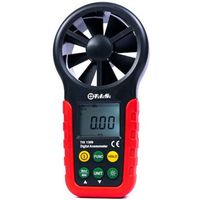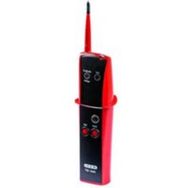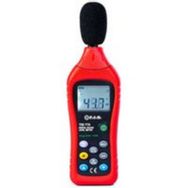Anemometer
Discover our great range of anemometers from leading brands. Anemometers are used for monitoring environmental conditions like wind speed and air velocity and are commonly used by meteorologists, farmers, pilots and engineers in outdoor environments.
Shop anemometers today and get free UK delivery on orders over £50 (excluding VAT).
Lamp & Lighting Testers
Sound Level Meter
Digital Anemometer
FAQs
How does an anemometer measure wind speed?
Traditionally known as a wind gauge or wind speed meter, anemometers work in different ways depending on their design. For example, the cup anemometer has small cups that spin when the wind pushes them.
The faster the wind blows, the faster the cups spin. Other anemometers use blades or special sensors to track changes in temperature caused by the wind.
Can an anemometer also measure wind direction?
Some anemometers, such as those with a vane anemometer design, can measure both wind speed and direction. The vane rotates according to the direction of the wind, providing data on both wind direction and wind speed.
What is the word anemometer derived from?
The word anemometer comes from the Greek word anemos, meaning wind, and metron, meaning *measure. It literally translates to a device used to measure wind, including its speed and in some cases its direction or temperature.
What are the different types of anemometers?
Cup anemometers use spinning cups to gauge speed, while vane anemometers track both speed and direction. Hot wire anemometers rely on the cooling effect of wind on a heated wire to measure air velocity. As the air flow past the wire increases, it cools down the wire, and the change in temperature is used to calculate wind velocity or air motion.
These are often used in extremely delicate environments like laboratories or HVAC systems. Laser Doppler anemometers are high-precision tools used to detect wind flow and air motion in fluid dynamics and environmental research. They work by measuring the frequency shift of laser light scattered by particles in the air, offering extremely accurate data about wind speed and direction.
Mechanical anemometers, like those with rotating cups or blades, are among the most common.
What is the difference between a wind vane and an anemometer?
A wind vane measures wind direction, while an anemometer measures wind speed.
Can an anemometer be used for other purposes besides measuring wind speed?
Some anemometers can also measure air temperature, relative humidity and air pressure, making them useful for environmental assessments such as heating and cooling ventilation units and weather forecasting.
How accurate are anemometers?
Anemometers can be very accurate, with laser Doppler anemometers offering high precision in measuring wind speed and wind velocity.
Factors affecting accuracy include the type of anemometer and the environmental conditions they are used in.
What are some common uses for anemometers?
Anemometers are commonly used in weather stations to track wind speed, average wind direction and air temperature.
They are also used in the industrial and commercial sectors for monitoring air circulation and ensuring proper environmental conditions.
They are commonly used in aviation, weather forecasting, wind farming, climate research and even in sports, for example paragliding or kiteboarding.
What is a three cup or four cup anemometer?
A three cup anemometer has three evenly spaced cups mounted on horizontal arms that spin as the wind blows. A four cup anemometer works similarly but includes an extra cup, which can provide slightly different readings depending on wind turbulence and rapid velocity fluctuations.
Both types are considered air meters and are widely used in weather stations for reliable wind speed data.
What are some handy features to look for when choosing my anemometer?
When choosing an anemometer, look for features with the ability to measure wind speed and direction, air velocity, and air temperature.
Models with digital displays and data logging are also useful, along with weather station compatibility for more comprehensive environmental readings.
The latest technology includes laser Doppler anemometers, which use lasers to precisely measure wind velocity, and the integration of sensors that can also measure air pressure and barometric pressure for more detailed environmental data.





